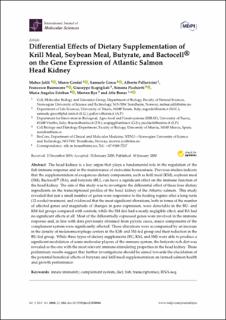| dc.contributor.author | Jalili, Mahsa | |
| dc.contributor.author | Gerdol, Marco | |
| dc.contributor.author | Greco, S. | |
| dc.contributor.author | Pallavicini, Alberto | |
| dc.contributor.author | Buonocore, Francesco | |
| dc.contributor.author | Scapigliati, Giuseppe | |
| dc.contributor.author | Picchietti, Simona | |
| dc.contributor.author | Esteban, Maria Angeles | |
| dc.contributor.author | Rye, Morten Beck | |
| dc.contributor.author | Bones, Atle M. | |
| dc.date.accessioned | 2020-09-28T08:57:46Z | |
| dc.date.available | 2020-09-28T08:57:46Z | |
| dc.date.created | 2020-01-30T10:56:27Z | |
| dc.date.issued | 2020 | |
| dc.identifier.citation | International Journal of Molecular Sciences. 2020, 21 (3), 886-?. | en_US |
| dc.identifier.issn | 1422-0067 | |
| dc.identifier.uri | https://hdl.handle.net/11250/2679893 | |
| dc.description.abstract | The head kidney is a key organ that plays a fundamental role in the regulation of the fish immune response and in the maintenance of endocrine homeostasis. Previous studies indicate that the supplementation of exogenous dietary components, such as krill meal (KM), soybean meal (SM), Bactocell® (BA), and butyrate (BU), can have a significant effect on the immune function of the head kidney. The aim of this study was to investigate the differential effect of these four dietary ingredients on the transcriptional profiles of the head kidney of the Atlantic salmon. This study revealed that just a small number of genes were responsive to the feeding regime after a long-term (12 weeks) treatment, and evidenced that the most significant alterations, both in terms of the number of affected genes and magnitude of changes in gene expression, were detectable in the BU- and KM-fed groups compared with controls, while the SM diet had a nearly negligible effect, and BA had no significant effects at all. Most of the differentially expressed genes were involved in the immune response and, in line with data previously obtained from pyloric caeca, major components of the complement system were significantly affected. These alterations were accompanied by an increase in the density of melanomacrophage centers in the KM- and SM-fed group and their reduction in the BU-fed group. While three types of dietary supplements (BU, KM, and SM) were able to produce a significant modulation of some molecular players of the immune system, the butyrate-rich diet was revealed as the one with the most relevant immune-stimulating properties in the head kidney. These preliminary results suggest that further investigations should be aimed towards the elucidation of the potential beneficial effects of butyrate and krill meal supplementation on farmed salmon health and growth performance. | en_US |
| dc.language.iso | eng | en_US |
| dc.publisher | MDPI | en_US |
| dc.rights | Navngivelse 4.0 Internasjonal | * |
| dc.rights.uri | http://creativecommons.org/licenses/by/4.0/deed.no | * |
| dc.title | Differential Effects of Dietary Supplementation of Krill Meal, Soybean Meal, Butyrate, and Bactocell® on the Gene Expression of Atlantic Salmon Head Kidney | en_US |
| dc.type | Peer reviewed | en_US |
| dc.type | Journal article | en_US |
| dc.description.version | publishedVersion | en_US |
| dc.source.pagenumber | 886-? | en_US |
| dc.source.volume | 21 | en_US |
| dc.source.journal | International Journal of Molecular Sciences | en_US |
| dc.source.issue | 3 | en_US |
| dc.identifier.doi | https://doi.org/10.3390/ijms21030886 | |
| dc.identifier.cristin | 1786050 | |
| dc.description.localcode | © 2020 by the authors. Licensee MDPI, Basel, Switzerland. This article is an open access article distributed under the terms and conditions of the Creative Commons Attribution (CC BY) license (http://creativecommons.org/licenses/by/4.0/). | en_US |
| cristin.ispublished | true | |
| cristin.fulltext | original | |
| cristin.qualitycode | 1 | |

